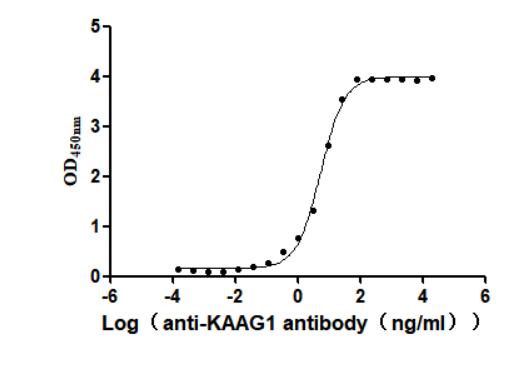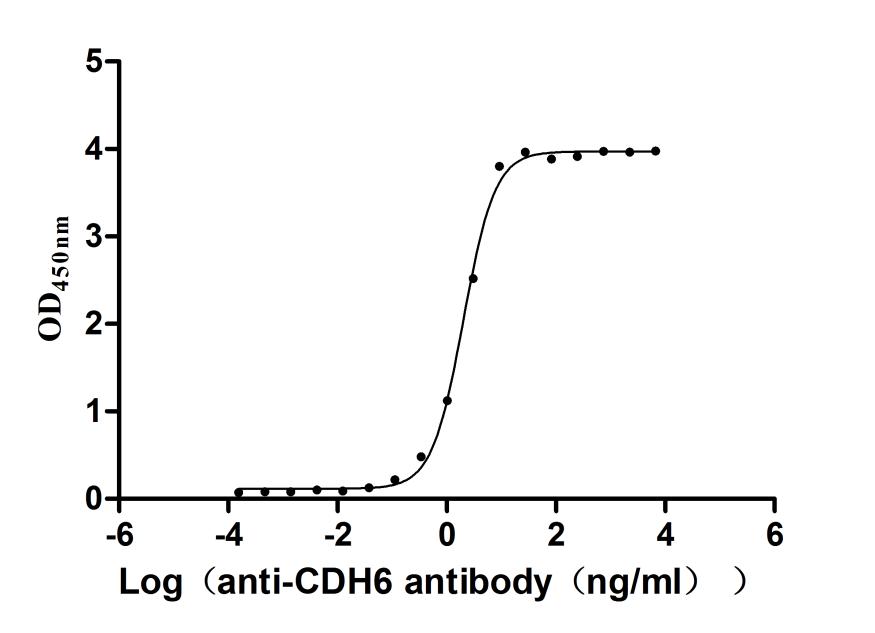Recombinant Autographa californica nuclear polyhedrosis virus Major envelope glycoprotein (GP64), partial
-
中文名稱:Recombinant Autographa californica nuclear polyhedrosis virus Major envelope glycoprotein(GP64),partial
-
貨號:CSB-YP324635ARA1
-
說明書:
-
規格:
-
來源:Yeast
-
其他:
-
中文名稱:Recombinant Autographa californica nuclear polyhedrosis virus Major envelope glycoprotein(GP64),partial
-
貨號:CSB-EP324635ARA1
-
說明書:
-
規格:
-
來源:E.coli
-
其他:
-
中文名稱:Recombinant Autographa californica nuclear polyhedrosis virus Major envelope glycoprotein(GP64),partial
-
貨號:CSB-EP324635ARA1-B
-
說明書:
-
規格:
-
來源:E.coli
-
共軛:Avi-tag Biotinylated
E. coli biotin ligase (BirA) is highly specific in covalently attaching biotin to the 15 amino acid AviTag peptide. This recombinant protein was biotinylated in vivo by AviTag-BirA technology, which method is BriA catalyzes amide linkage between the biotin and the specific lysine of the AviTag.
-
其他:
-
中文名稱:Recombinant Autographa californica nuclear polyhedrosis virus Major envelope glycoprotein(GP64),partial
-
貨號:CSB-BP324635ARA1
-
說明書:
-
規格:
-
來源:Baculovirus
-
其他:
產品詳情
-
純度:>85% (SDS-PAGE)
-
基因名:GP64
-
Uniprot No.:
-
別名:GP64; GP67; ORF128; Major envelope glycoprotein; gp64
-
種屬:Autographa californica nuclear polyhedrosis virus (AcMNPV)
-
蛋白長度:partial
-
蛋白標簽:Tag?type?will?be?determined?during?the?manufacturing?process.
The tag type will be determined during production process. If you have specified tag type, please tell us and we will develop the specified tag preferentially. -
產品提供形式:Lyophilized powder Warning: in_array() expects parameter 2 to be array, null given in /www/web/cusabio_cn/public_html/caches/caches_template/default/content/show_product_protein.php on line 668
Note: We will preferentially ship the format that we have in stock, however, if you have any special requirement for the format, please remark your requirement when placing the order, we will prepare according to your demand. -
復溶:We recommend that this vial be briefly centrifuged prior to opening to bring the contents to the bottom. Please reconstitute protein in deionized sterile water to a concentration of 0.1-1.0 mg/mL.We recommend to add 5-50% of glycerol (final concentration) and aliquot for long-term storage at -20℃/-80℃. Our default final concentration of glycerol is 50%. Customers could use it as reference.
-
儲存條件:Store at -20°C/-80°C upon receipt, aliquoting is necessary for mutiple use. Avoid repeated freeze-thaw cycles.
-
保質期:The shelf life is related to many factors, storage state, buffer ingredients, storage temperature and the stability of the protein itself.
Generally, the shelf life of liquid form is 6 months at -20°C/-80°C. The shelf life of lyophilized form is 12 months at -20°C/-80°C. -
貨期:Delivery time may differ from different purchasing way or location, please kindly consult your local distributors for specific delivery time.Note: All of our proteins are default shipped with normal blue ice packs, if you request to ship with dry ice, please communicate with us in advance and extra fees will be charged.
-
注意事項:Repeated freezing and thawing is not recommended. Store working aliquots at 4°C for up to one week.
-
Datasheet :Please contact us to get it.
相關產品
靶點詳情
-
功能:Class III viral fusion protein. Envelope phosphoglycoprotein which mediates the fusion of viral and host endosomal membranes leading to virus entry into the host cell. After receptor-mediated internalization of the virus, gp64 undergoes conformational change into a fusion-competent state at low pH, and the nucleocapsid is released into the cytoplasm after cell fusion. May also play role in budding.
-
基因功能參考文獻:
- The authors identified 4 critical residues in domain V (G438, W439, T452, and T456) that are important for membrane fusion, and two residues (G438 and W439) that appear to be important for formation or stability of the pre-fusion conformation of GP64. PMID: 26655244
- Viral GP64 mediated virus entry into the mammalian cells. PMID: 22190715
- Residues 271 and 292 of gp64 protein is important for binding to mammalian cells but not to Sf9 insect cells. PMID: 22072779
- The intermolecular disulfide bonds of GP64 is not essential for membrane fusion and virion budding. PMID: 20573818
- These results show that in addition to its basic role in membrane anchoring, the GP64 TM domain is critically important for GP64 trafficking, membrane fusion, virion budding, and virus infectivity. PMID: 18216100
- amino acids at positions 485 to 487 and 503 to 505 are important for cell surface expression of GP64, while amino acids at positions 483 to 484 and 494 to 496 are important for virus budding PMID: 19244324
- Results suggest that several conserved residues of Autographa californica multicapsid nucleopolyhedrovirus GP64 protein (T463, G460, G462, and G474) were not required for membrane fusion but were important for budding and viral infectivity. PMID: 19692475
顯示更多
收起更多
-
亞細胞定位:Virion membrane; Single-pass membrane protein. Host cell membrane; Single-pass membrane protein.
-
蛋白家族:Baculoviridae gp64 family
-
數據庫鏈接:
KEGG: vg:1403961
Most popular with customers
-
Recombinant Human Ephrin-A5 (EFNA5) (Active)
Express system: Mammalian cell
Species: Homo sapiens (Human)
-
Recombinant Human CUB domain-containing protein 1 (CDCP1), partial (Active)
Express system: Mammalian cell
Species: Homo sapiens (Human)
-
Recombinant Human Interleukin-2 (IL2) (Active)
Express system: Mammalian cell
Species: Homo sapiens (Human)
-
Recombinant Human Kidney-associated antigen 1(KAAG1) (Active)
Express system: Baculovirus
Species: Homo sapiens (Human)
-
Recombinant Mouse Cadherin-6 (Cdh6), partial (Active)
Express system: Mammalian cell
Species: Mus musculus (Mouse)
















